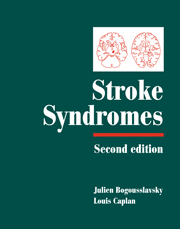Book contents
- Frontmatter
- Contents
- List of contributors
- Preface
- PART I CLINICAL MANIFESTATIONS
- PART II VASCULAR TOPOGRAPHIC SYNDROMES
- 29 Arterial territories of human brain
- 30 Superficial middle cerebral artery syndromes
- 31 Lenticulostriate arteries
- 32 Anterior cerebral artery
- 33 Anterior choroidal artery territory infarcts
- 34 Thalamic infarcts and hemorrhages
- 35 Caudate infarcts and hemorrhages
- 36 Posterior cerebral artery
- 37 Large and panhemispheric infarcts
- 38 Multiple, multilevel and bihemispheric infarcts
- 39 Midbrain infarcts
- 40 Pontine infarcts and hemorrhages
- 41 Medullary infarcts and hemorrhages
- 42 Cerebellar stroke syndromes
- 43 Extended infarcts in the posterior circulation (brainstem/cerebellum)
- 44 Border zone infarcts
- 45 Classical lacunar syndromes
- 46 Putaminal hemorrhages
- 47 Lobar hemorrhages
- 48 Intraventricular hemorrhages
- 49 Subarachnoid hemorrhage syndromes
- 50 Brain venous thrombosis syndromes
- 51 Carotid occlusion syndromes
- 52 Cervical artery dissection syndromes
- 53 Syndromes related to large artery thromboembolism within the vertebrobasilar system
- 54 Spinal stroke syndromes
- Index
- Plate section
50 - Brain venous thrombosis syndromes
from PART II - VASCULAR TOPOGRAPHIC SYNDROMES
Published online by Cambridge University Press: 17 May 2010
- Frontmatter
- Contents
- List of contributors
- Preface
- PART I CLINICAL MANIFESTATIONS
- PART II VASCULAR TOPOGRAPHIC SYNDROMES
- 29 Arterial territories of human brain
- 30 Superficial middle cerebral artery syndromes
- 31 Lenticulostriate arteries
- 32 Anterior cerebral artery
- 33 Anterior choroidal artery territory infarcts
- 34 Thalamic infarcts and hemorrhages
- 35 Caudate infarcts and hemorrhages
- 36 Posterior cerebral artery
- 37 Large and panhemispheric infarcts
- 38 Multiple, multilevel and bihemispheric infarcts
- 39 Midbrain infarcts
- 40 Pontine infarcts and hemorrhages
- 41 Medullary infarcts and hemorrhages
- 42 Cerebellar stroke syndromes
- 43 Extended infarcts in the posterior circulation (brainstem/cerebellum)
- 44 Border zone infarcts
- 45 Classical lacunar syndromes
- 46 Putaminal hemorrhages
- 47 Lobar hemorrhages
- 48 Intraventricular hemorrhages
- 49 Subarachnoid hemorrhage syndromes
- 50 Brain venous thrombosis syndromes
- 51 Carotid occlusion syndromes
- 52 Cervical artery dissection syndromes
- 53 Syndromes related to large artery thromboembolism within the vertebrobasilar system
- 54 Spinal stroke syndromes
- Index
- Plate section
Summary
The syndrome of intracranial vein and sinus thrombosis or cerebral venous thrombosis (CVT) has been recognized since the early part of the nineteenth century, when Ribes (1825) described the clinical and autopsy findings in a 45- year-old man with disseminated malignancy and thrombosis of the superior sagittal sinus (SSS), left lateral sinus (LS), and a cortical vein. For a long time, CVT was considered a rare disease associated with a poor prognosis, and because confirmation was by autopsy initially, only severe manifestations were recognized (Ehlers & Courville, 1936; Symonds, 1937; Garcin & Pestel, 1949; Barnett & Hyland, 1953; Kalbag & Woolf, 1967; Krayenbuhl, 1967). Since the 1970s, the advent of sensitive neuroimaging techniques has clearly added to our understanding, earlier diagnosis and management of this condition, with effective treatments for both thrombosis and its underlying causes (Ameri & Bousser, 1992).
Venous anatomy
The intracranial venous system is considerably more variable than the arterial anatomy (Figs. 50.1 and 50.2). Blood from the brain is drained by cerebral veins which empty into dural sinuses, themselves drained mostly by internal jugular veins.
Veins
Cortical cerebral veins
These veins receive blood from the superficial medullary veins that begin about 2 cm beneath the cortex. They drain the cortex and the adjacent white-matter. The cortical cerebral veins can be subdivided into three groups, based on the venous sinus into which they empty (Lasjaunias & Berenstein, 1990): (i) a dorsomedial system draining the high convexity and midline cortical veins, mainly into the SSS or the inferior sagittal sinus; (ii) a posteroinferior (ventrolateral) group draining temporo-occipital cortical veins into the LS;
- Type
- Chapter
- Information
- Stroke Syndromes , pp. 626 - 650Publisher: Cambridge University PressPrint publication year: 2001
- 2
- Cited by



